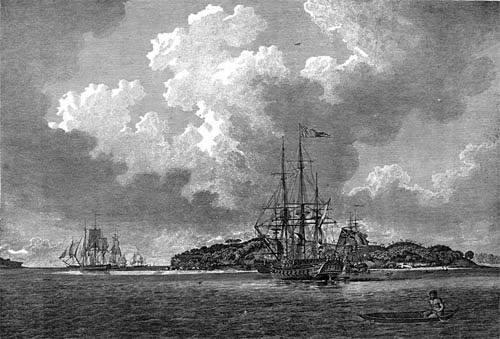Fishburn (1780 ship) facts for kids
| History | |
|---|---|
| Name | Fishburn |
| Owner | Leighton Co. |
| Launched | 1780, Whitby |
| General characteristics | |
| Tons burthen | 378, or 400 (bm) |
| Length | 103 ft (31 m) |
| Beam | 29 ft (8.8 m) |
| Sail plan | Ship rig |
| Complement | 22 |
| Armament | 6 guns |
The Fishburn was a special ship built in 1780 in Whitby, England. She was the largest of three "storeships" that sailed with the First Fleet. Storeships were like floating warehouses. They carried important supplies for the new settlement in Australia.
The Ship's Journey
The Fishburn first appeared in shipping records in 1781. Her master (captain) was named Gill, and her owner was J.Pierton. At that time, she was used for transport, often sailing from Cork. In 1785, she had a small accident. She was pushed onto a sandbank, but luckily, she wasn't badly damaged.
In 1787, the Fishburn became a key part of the First Fleet. This fleet was a group of ships that carried the first European settlers to Australia. Her master for this important voyage was Robert Brown. The ship was owned by Leighton Co. This company also owned two other ships in the fleet, the Golden Grove and the Borrowdale.
The Fishburn had a crew of 22 people. Before the journey began, some crew members left the ship. To make up for this, other sailors were transferred from HMS Hyaena. This was a Royal Navy ship that sailed with the First Fleet for the first part of its journey.
Voyage to Australia
The Fishburn left Portsmouth, England, on May 13, 1787. After a long journey across the ocean, she arrived at Port Jackson (which is now Sydney Harbour) on January 26, 1788. This was a very important day for the new colony.
After dropping off her supplies, the Fishburn began her return journey to England. She left Port Jackson on November 19, 1788. For some time, she sailed alongside the Golden Grove. However, they lost sight of each other near the Falkland Islands. The Fishburn stopped there for a few days. Some of her crew members were sick with scurvy, a disease caused by a lack of vitamin C.
The Fishburn finally arrived back in England on May 25, 1789. After this, her story becomes a bit of a mystery. She was officially taken out of service nine days after her arrival. After that, she seems to have disappeared from official records. Her final fate is not known.
Remembering the Fishburn
Even though her final fate is unknown, the Fishburn is remembered for her role in Australian history. There is a special monument to her in the First Fleet Memorial Gardens. These gardens are located in Wallabadah, New South Wales.
In 1985, a ferry in Sydney was named after the Fishburn. This ferry is part of the First Fleet ferry class. It helps to keep the memory of these important ships alive.
See also
- Journals of the First Fleet


